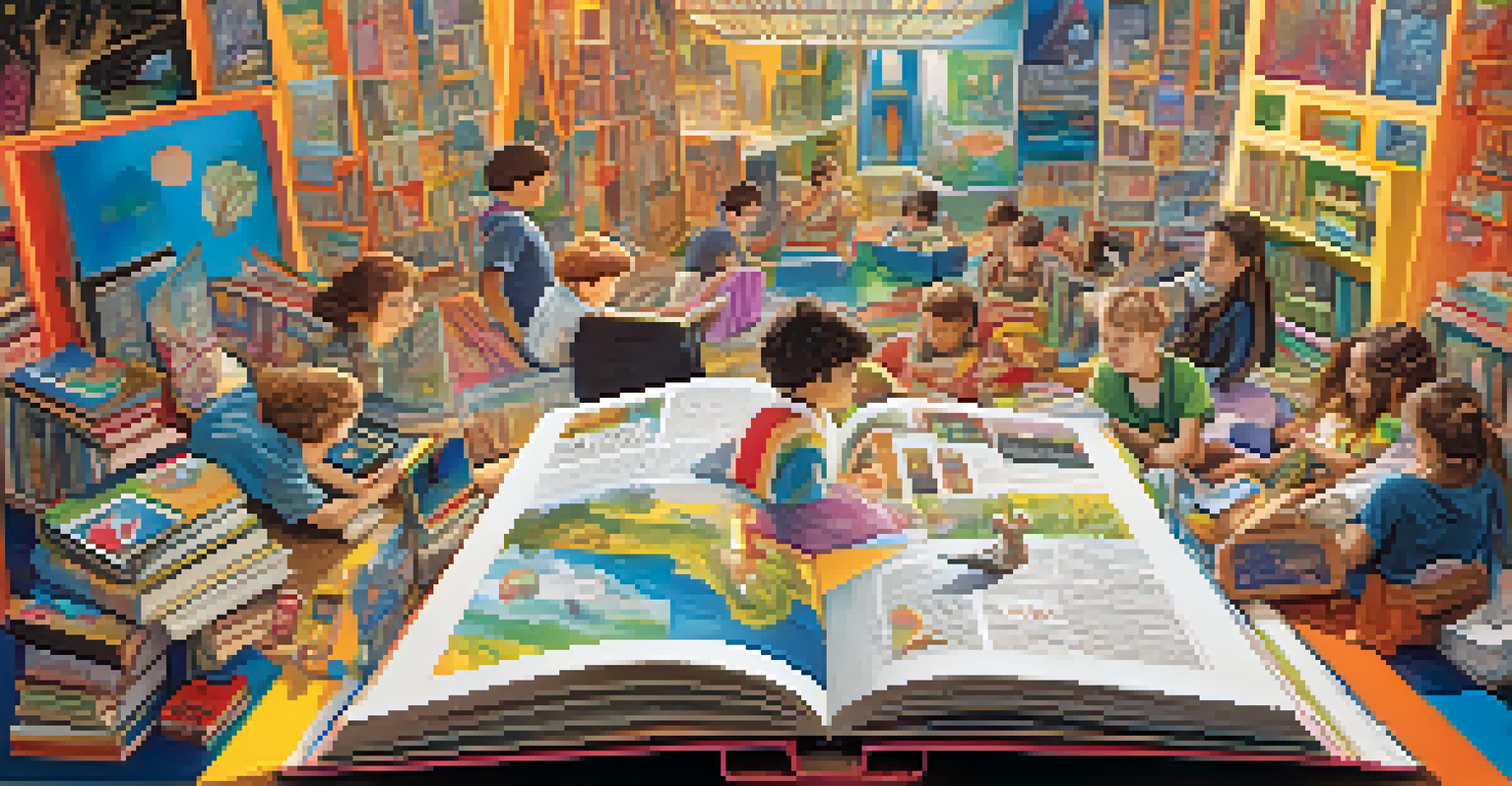The Role of Visual Literacy in Transmedia Learning

Understanding Visual Literacy and Its Importance
Visual literacy refers to the ability to interpret and create meaning from visual images. In our increasingly visual world, being visually literate is essential, especially in educational settings. It empowers learners to analyze images, videos, and other visual content critically, making them more effective communicators.
We are visual creatures; we think in pictures, images, and symbols.
The importance of visual literacy extends beyond mere interpretation; it fosters deeper engagement with content. For example, a student who can decode visual elements in a graphic novel will likely grasp the narrative's nuances better than one who struggles with visuals. This enhanced understanding can lead to improved academic performance and creativity.
Moreover, visual literacy promotes analytical skills that are crucial in today's information-rich environment. Learners equipped with these skills are more adept at discerning credible sources, recognizing bias, and synthesizing information from multiple mediums. Thus, the foundation of visual literacy is vital for thriving in a transmedia landscape.
Transmedia Learning: A Brief Overview
Transmedia learning involves the integration of multiple media formats to create a cohesive educational experience. It enables learners to engage with content across various platforms, such as books, films, games, and online resources. This approach caters to different learning styles and preferences, making education more inclusive.

For instance, a transmedia project might involve students exploring a historical event through a documentary, a novel, and an interactive website. This multi-faceted approach allows learners to connect the dots and see the bigger picture. It also encourages collaboration, as students can share insights gained from different media.
Visual Literacy Enhances Learning
Visual literacy empowers students to critically analyze and create meaning from various visual content, fostering deeper engagement and improved academic performance.
The flexibility of transmedia learning not only enhances engagement but also supports the development of critical thinking skills. As students navigate through diverse content, they learn to evaluate information, draw connections, and apply knowledge in innovative ways. In this context, visual literacy becomes an essential tool for success.
The Intersection of Visual Literacy and Transmedia Learning
At its core, visual literacy plays a crucial role in enhancing transmedia learning experiences. As students interact with various media formats, their ability to decode visual messages becomes increasingly important. This skill allows them to grasp concepts and themes that might otherwise be overlooked.
Visual literacy empowers individuals to interpret and create meaning from visual information, critical in a world flooded with images.
Consider a classroom project where students create a transmedia presentation on environmental issues. By utilizing infographics, videos, and social media, they can visually convey their message effectively. Those with strong visual literacy skills will excel in crafting compelling narratives that resonate with diverse audiences.
Furthermore, visual literacy encourages creativity in transmedia projects. When learners understand how to use visuals effectively, they can experiment with different formats and styles. This freedom to innovate not only enriches the learning experience but also cultivates a sense of ownership and pride in their work.
Enhancing Visual Literacy through Transmedia Projects
Transmedia projects offer an excellent opportunity to develop visual literacy skills. By engaging with multiple media formats, students can practice interpreting and creating visual content. This hands-on experience enables them to build confidence in their abilities and understand the nuances of visual communication.
For example, a project on storytelling could involve students creating a short film, designing a poster, and writing a blog post. Each medium requires different visual strategies, pushing students to think critically about how they present information. This variety not only solidifies their understanding but also makes learning enjoyable.
Transmedia Learning Supports Inclusion
By integrating multiple media formats, transmedia learning caters to diverse learning styles, making education more accessible and collaborative.
Additionally, transmedia projects promote collaboration, allowing students to learn from one another. Working in teams encourages discussion around visual choices and techniques, fostering a deeper understanding of visual literacy. This collective learning experience can lead to more creative and impactful projects.
Challenges in Integrating Visual Literacy into Transmedia Learning
While the benefits of visual literacy in transmedia learning are clear, challenges remain in its implementation. One significant obstacle is the varying levels of visual literacy among students. Some may struggle with interpreting visuals, while others may excel, leading to disparities in engagement and learning outcomes.
Teachers must be mindful of these differences and provide tailored support to help all students improve their visual literacy skills. This could involve offering targeted resources, such as workshops or tutorials, that focus on specific visual communication techniques. By doing so, educators can ensure that every student has the opportunity to thrive.
Another challenge is the rapid pace of technological change. As new media formats emerge, educators must continuously update their teaching methods and materials. Staying informed about current trends in visual literacy is essential for fostering effective transmedia learning experiences.
Tools and Resources for Developing Visual Literacy
There are numerous tools and resources available to help educators enhance visual literacy in transmedia learning. Online platforms like Canva, Piktochart, and Adobe Spark empower students to create visually engaging content with ease. These tools enable learners to experiment with design elements and develop their unique styles.
Additionally, educators can leverage free online courses and tutorials focusing on visual literacy. Websites like Coursera and Khan Academy offer valuable resources that teach students how to analyze and create visual content. Integrating these resources into the curriculum can significantly enhance students' visual literacy skills.
Future Skills Demand Visual Literacy
As technology evolves, strong visual literacy skills will be essential for students to navigate complex media environments and personalize their learning experiences.
Furthermore, educators can encourage students to explore various media formats outside the classroom. By engaging with documentaries, graphic novels, and interactive websites, learners can find inspiration and expand their visual literacy repertoire. This exploration not only enriches their understanding but also fosters a lifelong love for learning.
The Future of Visual Literacy in Transmedia Learning
As technology continues to evolve, the role of visual literacy in transmedia learning will only become more significant. With the rise of virtual reality, augmented reality, and interactive storytelling, the need for strong visual literacy skills will be paramount. Educators must prepare students to navigate these complex environments effectively.
Moreover, the integration of visual literacy into transmedia learning can lead to more personalized and engaging educational experiences. As students become adept at interpreting and creating visuals, they can tailor their learning journeys to suit their unique interests and preferences. This approach not only enhances motivation but also fosters deeper connections to the content.

Ultimately, investing in visual literacy education will equip students with essential skills for the future. As they become proficient in visual communication, they will be better prepared to tackle challenges in an increasingly visual world. The potential for growth and innovation in transmedia learning is boundless, and visual literacy is at its heart.